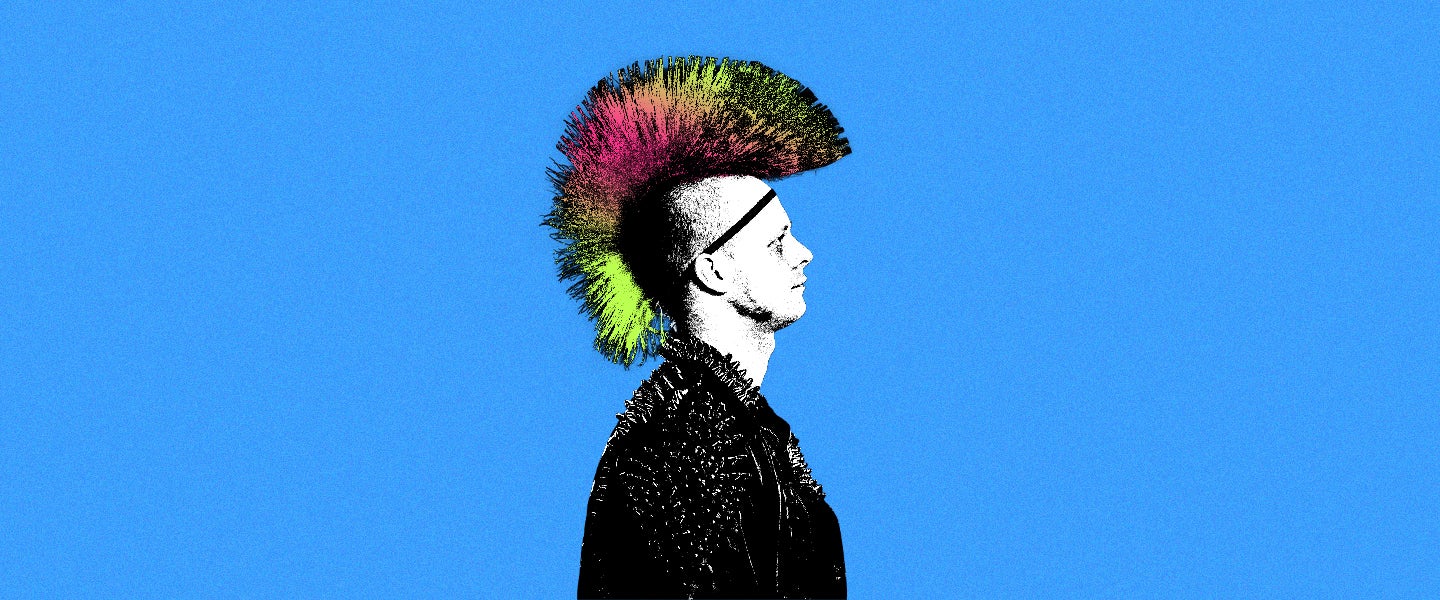Humans have sported eccentric hairstyles for millennia, and mohawks have almost always been one of them. Case in point: In 2003, numerous 2,300-year-old bodies were found deep within a bog near Dublin, and one was still wearing a mohawk held in place with oil and pine resin. Ancient people can also be seen with spiked hair running down the middle of their head in Siberian art dating back to 600 BCE. (So is it more accurate to say that eccentric people have been wearing mohawks for millennia than the other way around?)
Despite allegedly being named after the Mohawk people, an indigenous tribe that originally inhabited the Mohawk Valley in Upstate New York, history holds that the mohawk hairstyle we know today was more often worn by the Pawnee, who lived in present-day Nebraska and Northern Kansas. Surprise, surprise — it was Hollywood that perpetuated this association between the hairstyle and the Mohawk people when Drums Along the Mohawk was released in 1939. The movie was set in the Mohawk Valley and featured depictions of Native Americans with the mohawk hairstyle. In reality, though, the Mohawk people wore a square tuft of hair toward the back of the head, not a mohawk.
More recently, during World War II, some U.S. paratroopers wore mohawks and painted their faces in an attempt to intimidate the enemy (no word on whether that worked). A number of American troops followed suit during the Vietnam War. Around that same time, the hairstyle started becoming popular with the creative class, including the immensely influential jazz musician Sonny Rollins.
Which brings us closer to modern times, where, in the 1970s and 1980s, we saw the punk-rock community, particularly in London, co-opt the mohawk. “In the 1980s, people shifted away from the Mom-and-Pop era, and full expression was more accepted,” says hairstylist Sara Willner. The mohawk, then, was perhaps a bigger, more pointed (literally) statement than the long hair that was popular in the 1960s.
It was around this same time that Americans were introduced to Mr. T, who rocked an iconic mohawk on The A-Team. In an article for the Harvard Crimson, he explains, in his own way, why he chose this hairstyle:
“All right, let’s start with the hairstyle. People say, Oh Mr. T is about that hairstyle, why you get that hairstyle, is that punk rock, is that Mohican, are you a Mohawk? No, when they say that, I’m honored, because I’m proud to be along with the Mohican Indians and all that, but there’s a tribe in Africa, the country of Mali, that wear their hair this way, they’re called the Mandinke warriors. I trace it through the National Geographic magazine, so you know they don’t tell no lie. That wasn’t in People magazine, be better than your People magazine. But so the hairstyle like I said is a Mandinke, they wear it this way.”
Next, in the 1990s and early 2000s, while the mohawk itself was still around — Blink-182 drummer Travis Barker saw to that — we were also introduced to the less intense fauxhawk, which was arguably made most popular by David Beckham. Meanwhile, at the same time in the U.K., the fauxhawk was called the “Hoxton Fin,” named after the Hoxton district of London, where it was fashionable. According to Willner, in the early 2000s, the fauxhawk “was a mix between both classy and edgy.” In other words, fashion kinda reeled itself in at the time, and so did the mohawk.
Nowadays, the mohawk has become a sign of the times. For one, it’s polarizing, with some arguing that only Native Americans can wear the hairstyle; otherwise, it constitutes cultural appropriation. Second, it sticks out most on Instagram, where, of course, it can best be found via hashtag — and on an adorable animal.

